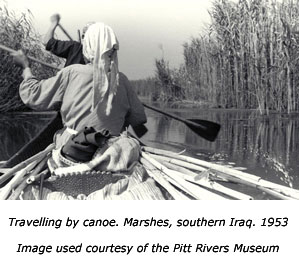August 31, 2005
The Pitt Rivers Museum, until 17 April 2006
Open every day 12pm - 4.30pm, admission free.
Wilfred Thesiger was one of this country's best known explorers and travel writers of the 20th century – a life of the kind we can now only dream of. He was born in Ethiopia, schooled in England (studying at Magdalen College) and in 1935 joined the Sudan Political Service. In World War II he was transferred to Syria, after which he spent 5 years travelling with the Bedu in Southern Arabia. He then spent 7 years living in the Marshes of Iraq. From this time onwards he lived as a writer and traveller, later settling in Kenya and eventually England. Since his death at age 93 in 2003, his photographic collection (consisting of 38,000 negatives, 75 albums and thousands of loose prints) has been housed at the Pitt Rivers. Until the 15th of January 2006 they have a selection of his photographs of Iraq on display. Open every day 12pm - 4.30pm, admission free.
Thesiger took over 4500 images of Iraq in the 1940s and 50s: portraits of men, women and children; shots of people at work, building canoes, fishing, waterproofing boats; and people on the move on annual migrations.
His photographs cover two very different areas of Iraq. The Marshes, an area in Southern Iraq, north west of Basra, is formed by the confluence of two rivers. When Thesiger visited, the area covered over 6,000 miles. Now only one tenth is left, as the area was systematically drained over the last two decades under Saddam Hussein's regime. Two dramatic images from this time are Spear Fishing (1958): five men poised in the prows of their boats, spears ready to strike, and Trees in a gale, Hamar (1953): palm trees bowed over with a lone figure walking through the shallow flood waters beneath.
The other area where Thesiger spent considerable time was in the northern, Kurdish-inhabited mountainous region. The population then were herders who undertook annual migrations - now they are settled farmers. There are a number of intimate and informative portraits from this period. A Sharafani man (1951) stares directly at us, wrapped up in layers of clothing from the cold: a padded jacket, blanket waistcoat, a flowered scarf round his waist, another scarf round his head and in the background a makeshift camp.
These works are a unique historical record of a land altered by successive wars and political regimes. They are certainly unrecognisable compared to contemporary news images, particularly in the portrayal of the people of Iraq. There are numerous favourable comments in the Visitors Book in the exhibition and the general appreciation seems best summed up by the following: “A stunning and timely view of an absolutely beautiful land and its people.”
In addition to the current exhibition, the Pitt Rivers has made over one hundred of Thesiger's lesser-known images of Arabia, Africa, Iraq and Asia available on their website. There are also interesting images of the man himself, for example a portrait taken in 1949 in the United Arab Emirates: a Lawrence of Arabia type figure, resting on a balcony.




